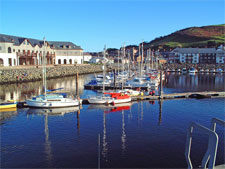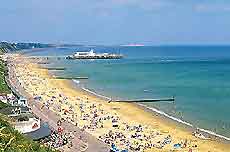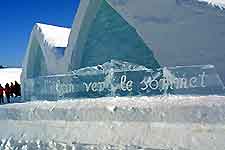World Guides Travel Blog
February 2015
This is where we let you know all about what's going on with our website and the world of travel, with destination reviews, current travel news and topical travel-related stuff to discuss with your friends. Please let us know if you want to comment on anything -
Contact us.
February 20, 2015
WET AND WONDERFUL WALES

Wales is one of my favourite places. I feel at home there. So, when I was offered the chance to visit the seaside town of Aberystwyth this week, I took it with both hands. As far as I'm concerned, Wales might be small, but it is perfectly formed. It is got everything, from spectacular mountain passes and Victorian promenades, to ancient castles and mile upon mile of sandy beaches.
As we crossed the Severn Bridge, I felt lucky indeed. The weather was being exceptionally kind. The small town of Abergavenny was bathed in sunshine and the sky was a shade of blue you would dream about on a summer's day, let alone in the middle of February. By the time we reached Rhayader, the twisty roads demanded all my concentration and storm clouds had begun to glower. Patches of snow were a reminder that winter still had Wales in its grip.
A seaside town in mid-winter can often feel a bit on the bleak side. I didn't get this impression with Aberystwyth, though - probably because the town's university attracts a large and lively student population. Our guesthouse was a mere stone's throw from the beach. Stepping outside into the darkness of the early evening, we heard the mesmerising sound of shifting waves on sand. It was strangely soothing.
The return leg offered a view of Wales at its wettest. The journey was characterised by bucketing rain that made it hard to see the road ahead, let alone the fantastic scenery that remained shrouded in banks of clouds. We flashed through villages, past rows of cottages with shiny slate roofs, before finally being tempted somewhere south of Builth Wells by a cafe offering Welsh teas (Bara brith and Welsh cakes, as it happens) and a warm welcome. Needless to say, we lingered quite a long time.
Finally, there was nothing for it but to watch the Welsh hills grow ever smaller in the rear view mirror. Headed back over the River Severn and into England, the Welsh word 'hiraeth' sprang to mind. Notoriously tricky to define, it is generally taken to mean a bittersweet mixture of nostalgia and yearning - a longing to return to a Welsh way of life. I shall certainly be back.
Posted by Sue at 10:49:20 on 20/2/2015
February 16, 2015
THE TREND FOR TUDOR TOURISM
Like millions of television viewers all over Britain, for the past few weeks I've been gripped by tales from Tudor times. Adapting Hilary Mantel's 'Wolf Hall' and its sequel 'Bring up the Bodies' for the small screen has proved hugely popular. Tudor England in the 16th century has been brilliantly brought to life, along with some of its key figures, including the hugely ambitious Thomas Cromwell and the ill-fated Anne Boleyn. It is hardly surprising, then, that the TV series has sparked off a whole new industry - Tudor tourism.
In particular, it seems that people's interest has been piqued by the stunning locations used in the filming of the series. Wolf Hall is actually Lacock Abbey in Wiltshire. Lacock, of course, is no stranger to film crews, famously appearing as a backdrop to two Harry Potter films. In Somerset, the National Trust-owned Montacute House served as the stunning setting for Greenwich Palace. It is here that, in the story, Anne Boleyn was arrested. Also in Somerset is Barrington Court, a Tudor manor house that has been used to represent York Place in Whitehall, home to Cardinal Wolsey.
The eagle-eyed among us might also spot star appearances by Raglan Castle in Monmouthshire, Broughton Castle in Oxfordshire, Great Chalfield Manor in Wiltshire, Chastleton House also in Oxfordshire, and the cathedrals of Gloucester and Winchester. Bristol Cathedral also gets a piece of the action. I could go on; the list comprises 30 places in all.
It has occurred to me - and no doubt to thousands of others - that some of Wolf Hall's filming locations would make a great weekend tour. It would include some of the best historic buildings in the south-west of England. Between them, they have been privy to centuries of political machinations and genteel family life. When the weather warms up, I might just give it a go.
Posted by Sue at 14:46:55 on 16/2/2015
February 8, 2015
A POTTED HISTORY OF THE HUMBLE PASSPORT PHOTO

I dread passport renewal time. Partly because of the form filling it entails, but mostly because of the dreaded photo. The rules seem to get longer and more arduous each time I head to my local post office, hair combed out of my eyes and smile removed from my face. Needless to say, the results are generally not good. Apparently, it hasn't always been like this. There was a time when you didn't even need a passport, let alone a photo. Then, one hundred years ago, in February, 1915, all that started to change.
World War One brought with it a whole new set of dangers and rules. Fears about foreign invaders were rife. A lack of photo identification could allow anyone and everyone to pose as someone they weren't, allowing spies to enter Britain with ease. So, in came the Nationality and Status Aliens Act of 1914. From then on, travellers were required not only to attach a photograph, but also to provide a brief personal description. If you had a large nose, you had to declare the fact. Likewise, there was no hiding small eyes or a round face. According to the reports of the day, some people objected to having to make such personal declarations.
Despite the tightening of rules, passport photo etiquette was still nowhere near as strict as it is today. In the early days, holiday photos could be used. Pretty much anything went. Famously, Sherlock Holmes author, Sir Arthur Conan Doyle posed with his wife and sons in a little cart. Bit by bit, restrictions were added, though, ranging from instructions to have 'full face showing' and 'no hats' in 1926, to 'small photos only' in 1941. A ban on long fringes and smiling arrived in 2004. These days, there are around 20 specific stipulations about what goes and what won't.
My most embarrassing experience of passport renewal was when I asked the man behind the post office counter whether he thought I needed a new photo for my application. Surely I hadn't changed that much since my last passport, issued ten years ago, and, therefore, wouldn't be obliged to go through the whole photo rigmarole. The man obliged by shouting across a crowded post office to his colleague. 'Do you think she looks older now?' he bellowed. I didn't wait for the answer. Instead, I dutifully combed my hair and fixed a neutral expression on my face.
Posted by Sue at 12:20:07 on 8/2/2015
February 1, 2015
LIFE IN THE WORLD'S COLDEST PLACES

Here in the UK, the sight of the first snowflake falling from the sky tends to bring with it a frisson of excitement. But when temperatures hover around zero and the snow starts to settle on roads and pavements, it suddenly becomes an inconvenience. Panic sets in. Motorways jam up, schools close. In short, life slows to a frozen snail's pace. Which set me to wondering how towns and cities in some of the coldest parts of the world cope with bone-chilling temperatures. Presumably, better than we do.
Whilst there is some dispute over which town can be classed as the coldest on earth, Oymyakon generally comes out on top. Situated in the north-east of Russia, the town often records an eye-watering temperature of minus 46°C (that is minus 50.8°F). A couple of hours' drive away, just south of the Arctic Circle, is an equally chilly Yakutsk. Other contenders for the 'coldest place on Earth' title include Yellowknife in the north-west of Canada and Ulaanbaatar, the capital city of Mongolia.
It is hard to get your head round what these sorts of temperatures mean to the people who do battle with them day after day. Apparently, they spend as little time outdoors as possible, rushing from car to house before frostbite sets in. Cars are kept in heated garages. When they are taken out, their engines are kept running at all times, even whilst the drivers are in a shop or running an errand. Turn the engine off, and it may never start again. Houses are built with crazy levels of insulation. Mobile phones have to be warmed up on a regular basis; otherwise, they would stop working. Vegetables can't grow because the ground is frozen, so anything fresh has to be grown in greenhouses. Fires have to be built before graves can be dug. The list is endless. And it goes without saying that getting dressed in the morning involves putting on lots of layers.
It is even harder to understand why anybody would want to put up with living in such extreme conditions. Surely, it would be easier to move to somewhere warmer. It seems to me, though, that for the people who live in these sorts of places, it is not really an issue. They just get on with it; they know how to cope. I'll remember that the next time I'm complaining about having to de-ice the car windscreen.
Posted by Sue at 12:07:28 on 1/2/2015
 Wales is one of my favourite places. I feel at home there. So, when I was offered the chance to visit the seaside town of Aberystwyth this week, I took it with both hands. As far as I'm concerned, Wales might be small, but it is perfectly formed. It is got everything, from spectacular mountain passes and Victorian promenades, to ancient castles and mile upon mile of sandy beaches.
Wales is one of my favourite places. I feel at home there. So, when I was offered the chance to visit the seaside town of Aberystwyth this week, I took it with both hands. As far as I'm concerned, Wales might be small, but it is perfectly formed. It is got everything, from spectacular mountain passes and Victorian promenades, to ancient castles and mile upon mile of sandy beaches. I dread passport renewal time. Partly because of the form filling it entails, but mostly because of the dreaded photo. The rules seem to get longer and more arduous each time I head to my local post office, hair combed out of my eyes and smile removed from my face. Needless to say, the results are generally not good. Apparently, it hasn't always been like this. There was a time when you didn't even need a passport, let alone a photo. Then, one hundred years ago, in February, 1915, all that started to change.
I dread passport renewal time. Partly because of the form filling it entails, but mostly because of the dreaded photo. The rules seem to get longer and more arduous each time I head to my local post office, hair combed out of my eyes and smile removed from my face. Needless to say, the results are generally not good. Apparently, it hasn't always been like this. There was a time when you didn't even need a passport, let alone a photo. Then, one hundred years ago, in February, 1915, all that started to change. Here in the UK, the sight of the first snowflake falling from the sky tends to bring with it a frisson of excitement. But when temperatures hover around zero and the snow starts to settle on roads and pavements, it suddenly becomes an inconvenience. Panic sets in. Motorways jam up, schools close. In short, life slows to a frozen snail's pace. Which set me to wondering how towns and cities in some of the coldest parts of the world cope with bone-chilling temperatures. Presumably, better than we do.
Here in the UK, the sight of the first snowflake falling from the sky tends to bring with it a frisson of excitement. But when temperatures hover around zero and the snow starts to settle on roads and pavements, it suddenly becomes an inconvenience. Panic sets in. Motorways jam up, schools close. In short, life slows to a frozen snail's pace. Which set me to wondering how towns and cities in some of the coldest parts of the world cope with bone-chilling temperatures. Presumably, better than we do.